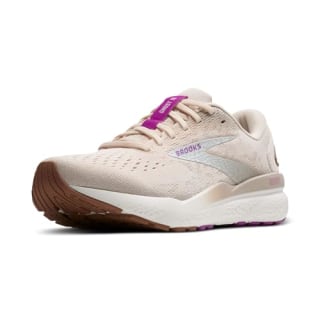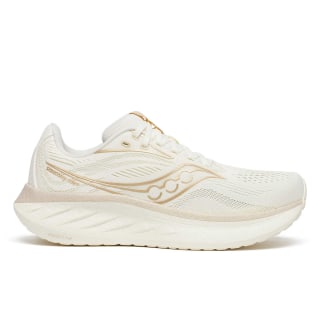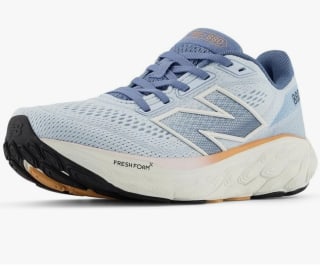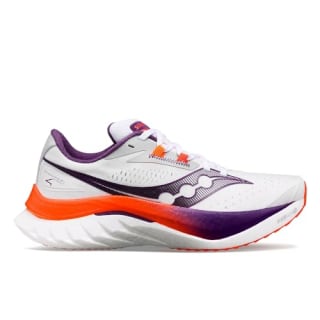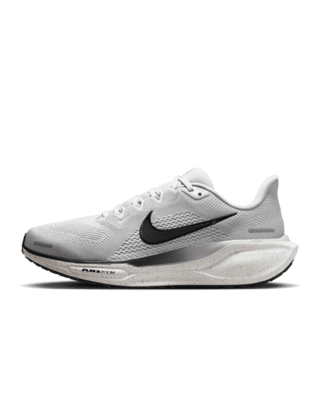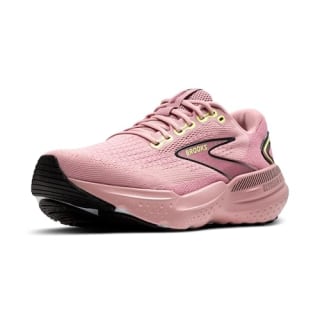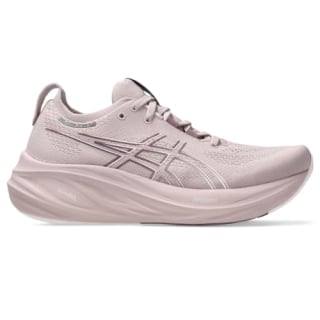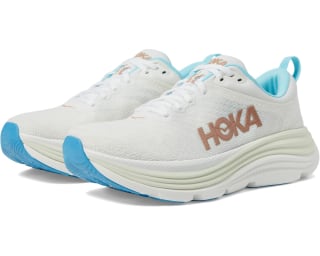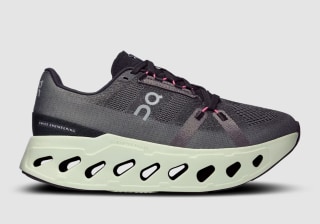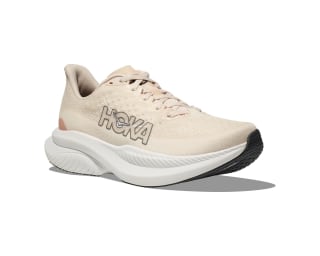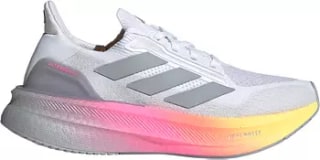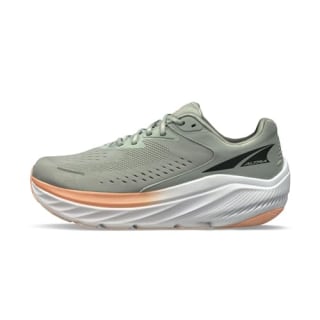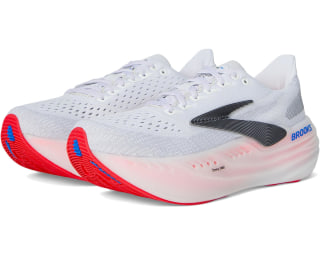There are many things you can’t control when you go for a run: the treadmills are occupied at the gym, it starts raining halfway through your workout or a street is closed on your favorite route, for example. One thing you have complete control over? Your running shoes.
As a runner for about a decade, I can confidently say that sneakers can make or break your run. And while picking a pair can feel daunting due to the dozens of options on the market, it all comes down to comfort. “A really good pair of running shoes should almost disappear on your feet,” says Heini Tallent, a certified running coach and the owner of Elements Running Education. “You shouldn’t think about them and they shouldn’t get in the way of you doing your thing.”
I spoke to experts about how to shop for the best women’s running shoes, whether you’re a beginner or four-time marathoner. They also shared tips for finding the perfect fit and explained whether women’s running sneakers are actually different from men’s.
SKIP AHEAD How I picked the best women’s running shoes | The best running shoes for women | Why trust NBC Select
Want more from NBC Select? Sign up for our newsletter, The Selection, and shop smarter.
How I picked the best women’s running shoes
First thing first: You need to run in running shoes. Sneakers labeled as walking, training or workout shoes won’t cut it. “Running shoes are specifically designed for running miles and miles,” says Dr. Alicia Canzanese, a podiatrist, certified athletic trainer and owner of Gordon Podiatry in Glenside, Pennsylvania. “Their whole purpose is to help you strike the ground and propel you forward to the next step, and make sure you do so efficiently, effectively and safely to prevent injury.”
With that in mind, here are the most important factors experts recommend considering while shopping for running shoes.
- Terrain: You’ll often see sneakers labeled as road or trail running shoes. Road running shoes are best for treadmills, pavement or tracks. They have relatively thin, even treads on their outsoles, meaning the bottom part of the shoe that touches the ground. Trail running shoes, however, are best for outdoor trails. They have deeper, thicker, heavier and grippier treads on their outsoles that resemble snow tire treads. Because of the different tread patterns, you shouldn’t use trail running shoes for road or treadmill runs, says Canzanese.
- Material: Make sure the shoe’s upper — the part that covers the foot — is made from a lightweight, breathable material like mesh, says Canzanese. “If it’s too heavy, you’re just adding extra weight on your feet for all those miles,” she says. The weather conditions you’re running may also impact what material is best for you, says Tallent. If you’re running in warmer temperatures, you’ll want something more breathable, but if you’re running in colder temperatures, you’ll want something with more insulation. Some brands also make water-resistant running shoes that withstand rain and snow.
- Cushioning: You can tell how much cushioning a shoe has by looking at its stack height, which is the amount of material between the ground and your foot— the higher the stack height, the more cushioning a shoe has. Cushioning is important in a running shoe because it helps your body absorb shock and keeps your feet comfortable, says Canzanese. But there’s a tradeoff — more cushioning can make a shoe less stable. There’s no optimal amount of cushioning or a specific stack height you should look for while shopping. It’s a matter of personal preference, so you’ll likely have to try a few sneakers to find what’s right for you. Cushioning also ranges from pillowy soft to firm.
- Heel drop: Heel drop, or offset, is the height difference between a shoe’s heel and toe. It’s measured in millimeters. Heel drop impacts the distribution of cushioning: a higher heel drop gives shoes means there’s more cushioning in the heel than the toe and a lower heel drop means cushioning is pretty evenly distributed. Running shoes typically have a heel drop of between 4 and 10 mm. High-heel drop shoes are best for runners who strike the ground with their heel first, and low-heel drop shoes are best for runners who strike with their forefoot or midfoot first, says Canzanese.
- Arch support: While shopping for running sneakers, you may see pairs labeled as neutral, stability or cushioning shoes, which tend to be best for people with neutral, flat and high arches, respectively. You can figure out what type of arch you have using our guide. Sneakers can fall somewhere between a neutral, stability and cushioning shoe, so knowing your arch type is helpful, but it’s only one piece of the puzzle.
- Width: If you have wide feet, opt for a sneaker that’s either specifically designed for them or comes in a wide size. Some shoes are also available in narrow sizes, but they’re less common. The easiest way to tell if your sneakers are too wide or narrow is to get professionally fitted at a shoe store, but you can also figure it out at home by putting on a pair and looking at the laces, says Canzanese. If you have to cinch them together tightly, you’re probably wearing too wide shoes. If you have to loosen them so much that there’s not much lace left to tie at the top, you’re probably wearing shoes that are too narrow.
- Toe box: Your feet swell as you run, so you need room in the toe box to account for that, which helps prevent blisters. Make sure you can wiggle your toes comfortably when the shoes are tied and that there’s about one thumb’s width of space between the tip of your longest toe and the end of the shoe, says Canzanese. If you have bunions or hammer toes, consider buying a shoe with a wide-toe box.
- Size: Your running shoes must be the right size for your feet, so Tallent recommends getting professionally fitted before you start shopping, especially if you have a history of injuries. Also, keep in mind that women’s feet tend to get bigger and wider during pregnancy and menopause permanently, so Canzanese recommends getting your feet resized after experiencing either.
- Price: “When it comes to running shoes, you get what you pay for,” says Canzanese. “Lower priced options often aren’t very sturdy and their materials wear out quickly, while higher priced options are typically more durable and last longer.”
- Return policy: “A shoe might feel great when you first try it on, but you don’t know until you start running in it,” says Tallent. You may not realize there’s an issue until you start putting miles on them for a few weeks, so pay attention to a retailer’s return policy. Tallent recommends buying running shoes from brands offering 30-, 60- or 90-day trials — you can wear the sneakers for a few runs, and if you don’t love them, you can send them back for a refund.
The best women’s running shoes of 2025
The women’s running shoes I recommend below are expert or NBC Select staff picks. I tested many of them while running indoors on the treadmill and outdoors on the road. I included the following information about each pair: weight, material, heel drop, sizes and widths. All the sneakers come in various color options and half and full sizes.
Best overall: Brooks Ghost 16
I’ve run in these sneakers for years and think they’re a reliable road running shoe and comfortable to wear on the treadmill. Canzanese recommends them, too, saying they’re a great option for casual runners or advanced runners looking for a solid daily trainer. The sneakers have a moderate amount of cushioning, effectively absorbing shock while padding my feet without lifting me off the ground much. Their soft midsole — the section between a shoe’s upper and outsole that forms the main support system — and segmented heel pad promotes smooth heel-to-toe transitions, according to the brand. The Ghosts are designed with a wider toe box, so they’re typically comfortable for those with bunions or frequent joint pain in their big toes, says Canzanese.
Weight: 8.5 oz. | Material: mesh | Heel drop: 12 mm. | Sizes: 5 to 13 | Widths: standard, wide, narrow and extra wide
Best for casual runners: Saucony Ride 18
“I really like the Saucony Ride for casual runners who want a nice cushioned shoe, and have a relatively neutral arch and normal foot type,” says Canzanese. This sneaker is made with soft, lightweight, responsive foam and its breathable mesh upper is slightly stretchy to adapt to your foot shape. The shoe’s rubber outsole has groves that add traction, plus its heel collar is cushioned for added comfort.
Weight: 8 oz. | Material: mesh | Heel drop: 8 mm. | Sizes: 5 to 12 | Widths: standard and wide
Best daily trainer: New Balance Fresh Foam X 1080v14
Whether I reach for these sneakers for a four-mile warmup on the treadmill or a challenging 10-mile loop in Central Park, I know I’ll have a good run. I wear them weekly between my long-distance runs and speedwork, so they’re a staple in my rotation. Their cushioning keeps my feet incredibly comfortable, and while it’s on the softer side, I never feel like I’m sinking into it. The shoes have a bouncier feel and a gentle rocker-shaped outsole for smooth heel-toe transitions. They’re also made with a solid rubber outsole, which adds a touch of stiffness, helps with rebound and grips whatever surface I run on.
Weight: 8.3 oz. | Material: mesh | Heel drop: 6 mm. | Sizes: 5 to 13 | Widths: narrow, standard, wide and extra wide

Best for racing: Saucony Endorphin Speed 4
“My absolute favorite running shoe of the last few years is the Saucony Endorphin Speed 4,” says Tallent, who ran a few marathons in them and appreciates that they support her on long runs and while doing speedwork. NBC Select editorial director Lauren Swanson swears by them, too. “Even when I get tempted to switch, I always return to my Saucony Endorphins,” she says. “They have such a good spring, are roomy for long distances and are super lightweight. I’ve run three out of four of my marathons in them and plan to run many more in them, too.”
Tallent says the Saucony Endorphins are cushioned, but their foam isn’t super soft. They have a winged nylon plate in their midsole, which adds some rigidity while still giving you flexibility — the nylon plate is a friendlier version of a carbon plate, she says. The sneaker’s tongue is connected to its upper, so it doesn’t move as you run.
Weight: 7.2 oz. | Material: engineered mesh | Heel drop: 8 mm. | Sizes: 5 to 12 | Widths: standard
Best neutral shoe: Nike Pegasus 41
The Pegasus is one of Nike’s most basic sneakers for everyday road running. It has a moderate amount of cushioning in the midsole, a grippy waffle-patterned rubber outsole and a plush tongue and sock liner. The shoes also have reflective details to increase runners’ visibility in low-light conditions. I usually find Nike’s sneakers to be narrower, but these fit true to size, in my experience. They give my feet enough room to expand when I run longer distances and are comfortable to wear for hours.
Weight: 8.8 oz. | Material: mesh | Heel drop: 10 mm. | Sizes: 5 to 12 | Widths: regular and wide

Best for flat feet: Brooks Glycerin GTS
Brooks Go-To-Support, or GTS, sneakers are designed with the brand’s GuideRails system and are made from two pieces of firm foam on either side of the heel. It helps prevent overpronation, common in those with flat feet, and provides stability, according to the brand.
“I wear these running shoes because I have a flatter foot that needs a bit more support and stability, but I still want that lightweight, cushioned feel,” says Canzanese. “Some arch support shoes can feel a bit heavy, and some stability shoes can feel pretty firm, but the Brooks Glycerin GTS gives me the best combination of lightweight cushioning and arch support.” The shoes also have a flexible knit upper and a pillowy soft, responsive feel.
Weight: 9.2 oz. | Material: synthetic fabric | Heel drop: 10 mm. | Sizes: 5 to 12 | Widths: standard and wide
Best for high arches: Asics Gel-Nimbus 26
Feet with high arches are rigid and prone to rolling outward (over supination), so they have difficulty absorbing shock, says Canzanese. They need extra help from shoes with lots of cushioning, like the Asics Gel-Nimbus. The sneakers are made with a thick layer of soft foam and a gel material in the midsole that helps absorb shock, soften landings and contribute to smooth transitions, according to the brand. They have a plush, stretchy knitted tongue and collar, a grippy rubber outsole and reflective details.
NBC Select editor Lindsay Schneider has been wearing Asics for years and says the brand’s sneakers will always be her tried and true. “I’ve tried at least five or six models at this point, and each of them has always been consistently more comfortable than any other shoe brand I’ve ever worn,” she says. “They’re super cushiony and can withstand lots of use.”
Weight: 9.2 mm. | Material: knit | Heel drop: 8 mm. | Sizes: 5 to 13 | Widths: standard and wide
Best wide toe box: Hoka Gaviota 5
“If somebody comes to see me and they have bunions or joint pain in their big toes, or if they need more space at the front of their shoes in general, I recommend the Hoka Gaviotas,” says Canzanese. “They have a little bit of arch support built in, and they’re really roomy and round by the toe.” These sneakers are designed with Hoka’s H-Frame stabilizing system, which helps prevent overpronation, according to the brand. It’s composed of a strong piece of foam that runs along the perimeter of the midsole and connects in the middle. The Gaviotas also have a plush tongue and collar, a rocker-shaped outsole and a thick layer of soft cushioning.
Weight: 9.10 oz. | Material: creel jacquard | Heel drop: 6 mm. | Sizes: 5 to 12 | Widths: standard and wide

Best max cushioning: On Cloudeclipse
The Cloudeclipse is On’s most cushioned shoe, with a thick midsole that lifts you off the ground by about two inches. It’s one of my favorite running sneakers of the past year because it protects my joints and helps me continuously roll through strides. The soft yet firm foam creates a supportive barrier between the ground and my body, absorbing impact mile after mile. Meanwhile, the pods in the shoe’s midsole compress as my feet hit the ground and expand as I take off, softening my landings and propelling me forward. The Cloudeclipse’s tongue is connected to its upper to prevent it from moving while I’m running, and the rubber pads on its outsole add extra traction, especially in wet conditions.
Weight: about 10 oz. | Material: recycled polyester | Heel drop: 6 mm. | Sizes: 5 to 11 | Widths: standard

Best lightweight: Hoka Mach 6
“The best part about these sneakers is how lightweight they are, which is something I didn’t expect when I first saw them since they look chunkier than my other running shoes,” says NBC Select associate reporter Bianca Alvarez. “I feel like there’s nothing on my feet when I run in them. They help me move freely and quickly without my feet dragging or being weighed down.” The sneakers have a low-profile layer of semi-firm cushioning to keep your feet closer to the ground, and their grippy rubber outsole makes them extra durable, says Alvarez. The shoe’s tongue is connected to the upper, so it doesn’t move as you run.
Weight: 6.7 oz. | Material: creel jacquard | Heel drop: 5 mm. | Sizes: 5 to 11 | Widths: standard and wide
Best for walking and running: Adidas UltraBoost 5X
I recommend wearing the Adidas UltraBoost sneakers if you do intervals that involve short bursts of running with longer periods of walking. They’re simple, cushioned shoes made with lightweight, responsive foam that pads my feet regardless of pace. The sneakers also have a molded external heel support that adds stability and a grippy rubber outsole. One of my favorite parts of this sneaker is its knit upper, designed similarly to a pull-on shoe, so it doesn’t have a tongue. It hugs my feet and makes them feel very secure. Plus, I never worry about uncomfortable tongue migration during the workout.
Weight: 8.36 oz. | Material: mesh knit | Heel drop: 10 mm. | Sizes: 5 to 12 | Widths: standard

Best zero drop: Altra Via Olympus 2
Zero-drop shoes have a heel drop of zero, which means their cushioning is equally distributed across their midsole, putting your heel at the same level as your toes, says Tallent. She says they promote a natural foot position and stride, making them best for experienced runners with proper running technique. If you’ve never worn zero-drop running sneakers, it’s important to gradually ease into them or work with a coach to make sure you’re carrying yourself correctly to avoid injury, says Canzanese.
Altra is known for its zero drop shoes, like the Via Olympus 2, one of the brand’s most cushioned models. It has a thick, soft foam midsole, a grippy rubber rocker-shaped outsole and a molded heel collar that keeps your feet secure. The sneaker is also designed with a roomy toe box, allowing space to spread out your toes and making it suitable for those with bunions.
Weight: 9.6 oz. | Material: mesh | Heel drop: 0 mm. | Sizes: 5.5 to 12 | Widths: standard
Editor’s pick: Brooks Glycerin Max
I test over two dozen running sneakers a year, so it takes a lot to impress me with something that truly feels brand new — Brooks managed to do so recently with the Glycerin Max. It has a high stack height, billowy midsole and prominent rocker-shaped outsole; all features that feel like a big departure from the brand’s typical low-profile, streamlined silhouette. And I love it. The sneakers are bouncy and responsive, and once I start running in them, I don’t want to stop. They successfully absorb impact whether I’m running on the road or treadmill, protecting my joints and eliminating pain in my knees and ankles. I’m a big fan of the Glycerin Max, so much so that I have to force myself to rotate them with a different pair every few days.
Weight: 9.5 oz. | Material: mesh | Heel drop: 6 mm. | Sizes: 5 to 12 | Widths: standard
Meet our experts
At NBC Select, we work with experts with specialized knowledge and authority based on relevant training and/or experience. We also ensure that all expert advice and recommendations are made independently and without undisclosed financial conflicts of interest.
- Heini Tallent is a certified running coach and the owner of Elements Running Education.
- Dr. Alicia Canzanese is a podiatrist, certified athletic trainer and owner of Gordon Podiatry in Glenside, Pennsylvania.
Why trust NBC Select?
I’m a reporter at NBC Select who has covered health and fitness since 2020, including topics like sports bras, women’s walking shoes, training shoes, wrist weights and exercise mats. To write this article, I interviewed two experts about how to shop for women’s running shoes. I also rounded up recommendations from experts and NBC Select staff, and tested a handful of models myself.
Catch up on NBC Select’s in-depth coverage of tech and tools, wellness and more, and follow us on Facebook, Instagram, Twitter and TikTok to stay up to date.

